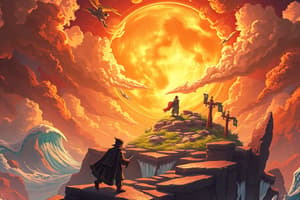Podcast
Questions and Answers
Which of the following is NOT considered a type of visual art?
Which of the following is NOT considered a type of visual art?
- Photography
- Sculpture
- Opera (correct)
- Painting
What is one key function of art that involves reflecting societal values and beliefs?
What is one key function of art that involves reflecting societal values and beliefs?
- Cultural (correct)
- Aesthetic
- Communicative
- Emotional
Which element of art refers to the perceived hue and value?
Which element of art refers to the perceived hue and value?
- Color (correct)
- Line
- Shape
- Form
Which art movement is characterized by the dramatic use of light and dynamic compositions?
Which art movement is characterized by the dramatic use of light and dynamic compositions?
Which artist is famous for the painting 'Starry Night'?
Which artist is famous for the painting 'Starry Night'?
Art criticism involves evaluating artworks through which of the following lenses?
Art criticism involves evaluating artworks through which of the following lenses?
Which of the following is a characteristic of Modernism in art?
Which of the following is a characteristic of Modernism in art?
What describes the three-dimensional aspect of an object in art?
What describes the three-dimensional aspect of an object in art?
Flashcards are hidden until you start studying
Study Notes
Definition of Art
- Expression of human creativity and imagination.
- Can take various forms including visual arts, performing arts, literature, and others.
Types of Art
- Visual Arts
- Painting, drawing, sculpture, photography, and printmaking.
- Performing Arts
- Theater, dance, music, and opera.
- Literary Arts
- Poetry, novels, short stories, and essays.
- Applied Arts
- Design disciplines like graphic design, industrial design, and fashion.
Functions of Art
- Aesthetic: Provides visual pleasure and enjoyment.
- Cultural: Reflects societal values, beliefs, and history.
- Emotional: Evokes feelings and stimulates emotional responses.
- Communicative: Conveys messages, ideas, and narratives.
Elements of Art
- Line: The path between two points; can vary in width, direction, and length.
- Shape: Two-dimensional area created by lines or color changes.
- Form: Three-dimensional object; possesses volume and mass.
- Color: Perceived hue, value, and intensity.
- Texture: Surface quality perceived through touch or visual representation.
- Space: The area around, between, and within objects; can imply depth.
Art Movements
- Renaissance: Focus on realism and human emotion.
- Baroque: Dramatic use of light and color, dynamic compositions.
- Impressionism: Focus on capturing light and momentary effects.
- Modernism: Break from tradition, experimentation in style.
- Postmodernism: Mixes different styles, questions art's original meaning.
Notable Artists
- Leonardo da Vinci: Known for "Mona Lisa" and "The Last Supper."
- Vincent van Gogh: Famous for "Starry Night" and expressive use of color.
- Pablo Picasso: Co-founder of Cubism; known for "Guernica."
- Frida Kahlo: Explored identity through personal symbolism in her self-portraits.
Art Criticism
- Involves evaluating and interpreting artworks through various lenses such as historical context, technique, and aesthetic experience.
Conclusion
- Art serves numerous purposes in society, from aesthetic enjoyment to cultural representation and emotional expression. Understanding its various forms, elements, and historical context enriches appreciation and engagement with artistic endeavors.
Definition of Art
- Art is an expression of human creativity and imagination.
- It encompasses various forms, including visual arts, performing arts, literature, and others.
Types of Art
- Visual Arts include painting, drawing, sculpture, photography, and printmaking.
- Performing Arts encompass theater, dance, music, and opera.
- Literary Arts include poetry, novels, short stories, and essays.
- Applied Arts incorporate design disciplines like graphic design, industrial design, and fashion.
Functions of Art
- Art serves aesthetic purposes, providing visual pleasure and enjoyment.
- It plays a cultural role, reflecting societal values, beliefs, and history.
- Art can emotionally evoke feelings and stimulate emotional responses.
- It serves as a communicative tool, conveying messages, ideas, and narratives.
Elements of Art
- Line is the path between two points, varying in width, direction, and length.
- Shape refers to a two-dimensional area created by lines or color changes.
- Form describes a three-dimensional object possessing volume and mass.
- Color is perceived hue, value, and intensity.
- Texture represents the surface quality perceived through touch or visual representation.
- Space is the area around, between, and within objects, implying depth.
Art Movements
- The Renaissance emphasized realism and human emotion.
- The Baroque movement showcased dramatic use of light and color, employing dynamic compositions.
- Impressionism focused on capturing light and momentary effects.
- Modernism broke from tradition, embracing experimentation in style.
- Postmodernism blended different styles and questioned art's original meaning.
Notable Artists
- Leonardo da Vinci is renowned for "Mona Lisa" and "The Last Supper."
- Vincent van Gogh is famous for "Starry Night" and his expressive use of color.
- Pablo Picasso, co-founder of Cubism, is known for "Guernica."
- Frida Kahlo explored identity through personal symbolism in her self-portraits.
Art Criticism
- Art criticism involves evaluating and interpreting artworks through various lenses, including historical context, technique, and aesthetic experience.
Conclusion
- Art serves numerous purposes in society, ranging from aesthetic enjoyment to cultural representation and emotional expression.
- Understanding its various forms, elements, and historical context enhances appreciation and engagement with artistic endeavors.
Studying That Suits You
Use AI to generate personalized quizzes and flashcards to suit your learning preferences.




